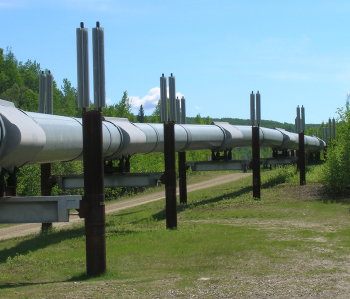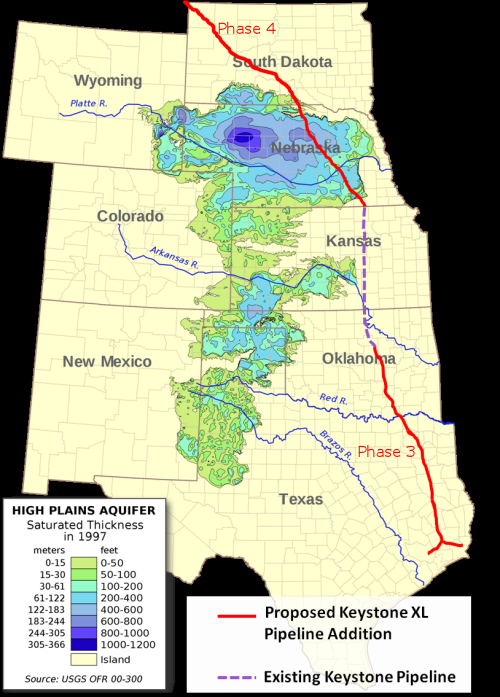How is the Keystone XL Oil Pipeline Progressing?
Four and a half years of studies and five failed votes in the House later, exactly where are we with the Keystone XL Oil pipeline? Stuck on the US-Canadian border where it is likely to remain until mid-2013 despite the headline-grabbing issuance of one of three permits to begin construction in Texas for the smaller and much less controversial portion of the pipeline.
 |
| Trans-Alaska Pipeline |
Only 1/3rd of OK/TX Portion Granted
On 26 June, the US Army Corps of Engineers granted TransCanada Corp one of three permits required in order to begin construction on the $2.3 billion southern section of the Keystone XL pipeline, which would run from Cushing, Oklahoma to the Gulf of Mexico in Texas. This first in the permit series covers construction across the wetlands and waterways of Texas’ Galveston district. TransCanada still needs two more permits from Tulsa, Oklahoma and Fort Worth, Texas, to complete this southern Gulf portion of the pipeline extension. Tulsa is set to rule on the second permit in a month and a half.
This southern section of the extended pipeline will carry 700,000 barrels a day of crude oil, to start with, to Texas refineries from Cushing. Construction will begin this summer. The southern line, permits permitting, could be functional by mid-to-late next year. Indeed, Obama pledged to speed up the approval process to make this a reality.
But these permits are only for the southern extension of the Keystone pipeline, which seeks to extend the existing Keystone pipeline from Cushing, Oklahoma to the Gulf of Mexico. This is a much less controversial piece of the pipeline project, which by dint of not crossing the US-Canadian border and which is being pursued by TransCanada independently from the rest of the Keystone XL pipeline extension, does not require complicated approval.
The current Keystone pipeline “Phase 1” runs from Hardisty in Alberta, Canada, then eastwards in Canada, dropping southwards into the US, to the United States refineries in Wood River, Illinois and Patoka, Illinois was completed in June 2010.
Phase 2 goes from Steele City, Nebraska, through Kansas to the oil hub and tank farm in Cushing, Oklahoma in 2010 and went online in February 2011. Phase 3 known as Cushing MarketLink, is
The Keystone “XL” Extension
Phase 3

In order to speed things up after President Obama initially rejected the project in January this year, TransCanada split the pipeline extension project into the northern and southern sections, pursuing the southern branch independently. On March 22, 2012, President Obama announced an approval of the Cushing, Oklahoma to the Gulf Coast portion of the pipeline.
Simply issuing permits to begin construction on the southern extension through Texas and Oklahoma does not signify that the Keystone XL project is progressing just yet. Because the much larger northern extension crosses an international border, it must first obtain presidential approval, in accordance with an executive order implemented under George W. Bush in 2004.
Phase 4
According to Wikipedia:
This phase is part of the Keystone XL pipeline and would start from the same area in Alberta, Canada as the main pipeline. The Canadian section would consist of 526 kilometres (327 mi) of new pipeline. It would enter the United States at Morgan, Montana and travel through Baker, Montana where domestic oil would be added to the pipeline, then it would travel through South Dakota and Nebraska, where it would join the existing Keystone pipelines at Steele City, Nebraska. This phase has generated the greatest controversy because of its routing over the top of the Ogallala Aquifer in Nebraska.
The comment period on the proposal began Jun. 15, 2012, and will continue until 30 July 2012, but the State Department has said it would not be able to complete its review of the process until the first quarter of 2013. Approval is still contingent upon whether the project is demonstratively in the country’s national interest.
Is Keystone XL in the National Interest
So, the trillion-dollar question is whether Keystone XL is in fact in the country’s national interest. The more urgent question of course is whether Keystone XL is in the Obama administration’s interests, specifically in the run-up to presidential elections.
On 27 June, House and Senate negotiators reached a tentative agreement over a two-year bill to overhaul federal highway and transit programs. A bill Obama had vowed to veto if there were any attempts to slip approval of Keystone XL in the legislation. Republicans backed down on including language that would approve the pipeline within the bill.
Is Keystone XL in the Obama Administration’s Interests?
The former question is complicated enough; the latter even more so. From an environment and jobs perspective, Keystone XL is not in the Obama administration’s interests. Organized labor is not as interested as it might be in the jobs this would create at a time when the administration has been fairly successful at creating energy jobs elsewhere. As far as environmental activists are concerned the Obama administration’s hesitancy over the project is the stuff of heroism.
The Republicans had hoped to deal Obama a lethal campaign blow by setting a two-month deadline for the administration to approve Keystone XL in January. The Republicans knew that two months was not nearly enough to evaluate the project from an environmental and economic aspect, and that the administration would have to reject the project. The idea was to force the administration into publicly denouncing massive job creation and working against US energy independence ahead of the elections.
This hasn’t been as successful as the Republicans had hoped. They had not counted on the relatively muted response from organized labor. The Obama administration has also racked up some very significant points in energy development that it can cash in on to replace the loss of Keystone XL, and that includes (clean) job creation that is keeping organized labor at bay.
In terms of the oil and gas industry, here, too, the Obama administration doesn’t have much to gain by approving Keystone XL ahead of the elections. It would not be the end-all for the oil lobby’s harassment of the administration.
Back to our first question:
Is Keystone XL in the country’s national interest? It is almost a moot point in an election year, but we will entertain the notion simply to avoid being labeled cynical. It will create plenty of jobs, which is hardly a contested point, but there are other energy-related jobs already being created rather successfully. Environmentally, the project flies in the face of the administration’s clean energy ambitions with the associated risk of oil spills and the increase in greenhouse gas emissions as a result of increased tar sands (dirty oil) extraction.
In terms of economics, there is some research showing that Keystone XL is more likely to result in higher prices at the pump. Canadian tar sands crude pumped into the Midwest and intended for domestic gas consumption would be diverted to the Gulf Coast where it would be used in diesel production and for global exports. It could very well mean reduced gas supplies and higher gas prices in the end.
Much like the Republican attempt to force Keystone XL to fail early on and force a vote loss on Obama, the issuance of the first Texas permit for the southern extension is but a Democratic bone to big oil and a job-hungry public. It has little marrow. The Republicans lost this battle when TransCanada split the project in half, allowing the Obama administration to score points by supporting the smaller version while avoiding a decision on the larger project.
Conclusion:
With the Government in pre-election gridlock, nothing will happen on the “greater” Keystone XL this year.
See Also:
Inflation adjusted Oil Price Chart
Oil, Investment and a Turkish Gamble
More Oil Articles
Source: Oilprice.com- Whatever Happened to the Keystone Pipeline?
By. Jen Alic of Oilprice.com
